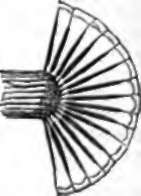

The material they chose for the artificial eyes was an epoxy resin that cures into a hardened form when exposed to ultraviolet light.

They then had a hemisphere-shaped cup pocked with some 8700 indentations: a compound-eye mold that could be used over and over again using soft lithography technology, a set of methods developed over the last decade to replicate nanoscale-sized (billionths of a meter) structures. By affixing the PDMS membrane over the opening of a vacuum chamber and applying negative air pressure, they pulled it into the dome shapes they needed, controlling its form by using different pressures. On top of this, they applied a thin slab of an elastic polymer called polydimethylsiloxane (PDMS), creating a concave pattern of the lenses in the polymer. Using existing technology, they made a flat array of these tiny, domed lenses arranged in the hexagonal honeycomb pattern. To create the artificial eye, the team first needed to construct a hemispherical mold of the eye's outer layer, a structure consisting of thousands of microlenses. While conventional microfabrication techniques are expensive and use high temperatures, Lee and his team borrowed from nature, using a low temperature system, photopolymerization and self-aligning, self-writing technology.Ī scanning electron microscope image of the surface of an artificial compound eye showing some of the 8700 hexagonal microlenses that make up its surface. "People have said that it would be totally impossible to create them with an angle, but now that we've done it, we're ready to integrate imaging or chemical sensing into the eyes." "The lenses and waveguides are the most important part of the system," Lee said. He also has plans to link them to spectroscopes for chemical detection and analysis. While an insect's ommatidia each end in a photoreceptor cell that transmits a light signal to the creature's optic nerve, Lee plans to couple his team's ommatidia with CCD photodiodes, the light-capturing units used in digital cameras and camcorders. Just like pins in a pincushion - or a dragonfly's 30,000 ommatidia - the team's artificial ommatidia are each oriented at a slightly different angle. His team has shown that the lenses and waveguides of the artificial eyes focus and conduct light in the same way as an insect's eye, Lee said. Not only are these units packed together in the same hexagonal, honeycomb pattern as in an insect's compound eye, but each is also remarkably similar in size, design, shape and function to an ommatidium, the individual sensory unit of a compound eye. What he and his team came up with is a low-cost, easy-to-replicate method of creating pinhead-sized polymer resin domes spiked with thousands of light-guiding channels, each topped with its own lens, he said. So, I started thinking about basing a fabrication system on the developmental stages of insect eyes that I'd learned about as a biophysicist and bioengineer." "I've always wanted to create an advanced, three-dimensional optical system," Lee said, "but conventional microfabrication technology is two-dimensional. The eyes are fully described for the first time in the April 28 issue of the journal Science. They are the first hemispherical, three-dimensional optical systems to integrate microlens arrays - thousands of tiny lenses packed side by side - with self-aligned, self-written waveguides, that is, light-conducting channels that themselves have been created by beams of light, said Lee, the Lloyd Distinguished Professor of Bioengineering at UC Berkeley. (Photos by Birgit Greiner and Luke Lee both courtesy Science magazine) Similar in size, shape and structure to an insect's compound eye (above) is the artificial compound eye (below) created by Luke P. Potential applications include surveillance, high-speed motion detection, environmental sensing, medical procedures that require cameras (such as endoscopies and image-guided surgeries) and a number of clinical treatments that can be controlled by implanted light-delivery devices. These eyes can eventually be used as sensory detectors to capture visual or chemical information from a wider field of vision than previously possible, even with the best fish-eye lens, said Luke P.

#Insect eye xsection series
BERKELEY, Calif., - Using the eyes of insects such as dragonflies and houseflies as models, a team of bioengineers at the University of California, Berkeley, has created a series of artificial compound eyes that could be used to make ultrathin camera phones or wearable cameras.


 0 kommentar(er)
0 kommentar(er)
